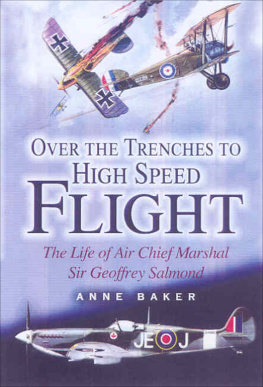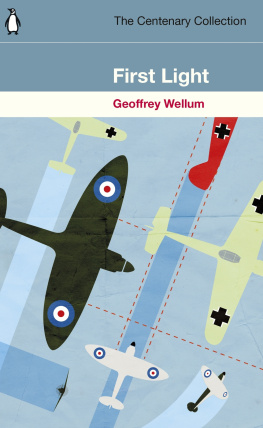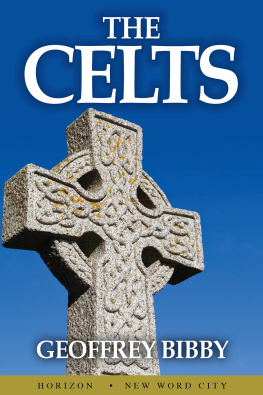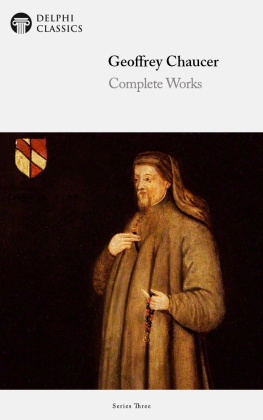First Published in Great Britain 2003 by
LEO COOPER
an imprint of Pen & Sword Books
47 Church Street
Barnsley, S. Yorkshire, S70 2AS
ISBN 0 85052 980 8
PRINT ISBN: 9780850529807
PDF ISBN: 9781783377565
EPUB ISBN: 9781783379767
PRC ISBN: 9781783379569
Copyright 2003 by Anne Baker
A CIP record for this book is available from the British Library
Typeset in 10/12.5pt Plantin by
Phoenix Typesetting, Auldgirth, Dumfriesshire.
Printed in England by
CPI UK
DEDICATION
To Penelope David, Peter, Rose, Chris and Julian
CONTENTS
FOREWORD
Bryan Watkins
Great in the field, in the air and in the council chamber, his character was so fine, his personality so lovable. His is indeed an irreparable loss.
Sir Philip Sassoon
Every student of the history of the war of 1914-18 knows that General Allenbys last great advance, which crushed the Turkish Army, was made possible by the Royal Flying Corps, inspired by Geoffrey Salmond and directed by his brilliant staff work. But everybody does not know how much British Aviation, in every activity, owes to his knowledge, energy and foresight since that war By the death of Geoffrey Salmond we have lost a great leader of men, a great organiser, a true statesman, and a fine technician. But above and beyond that, many have lost a very dear friend.
From an obituary by C.G. Grey
History is chary of awarding the accolade of greatness to any man. Indeed, such an award is all to often open to challenge as the years go by. However, there can be no challenging the fact that both Air Chief Marshal Sir Geoffrey Salmond KCB KCMG DSO and Bar and his younger brother Jack, Marshal of the Royal Air Force Sir John Salmond GCB CMG CVO DSO, were the only brothers to hold the supreme appointment of Chief of Air Staff in succession.
Whilst Jacks considerable achievements have been recorded for history by Dr John Laffin in his biography, Swifter than Eagles, no such records exist of those of his brother. Since Geoffreys tragically early death in 1933, they seem almost to have become lost in the mists of time. Yet it is to Geoffreys vision and wisdom that we owe so much that is now great in British Aviation. His early understanding of the possibilities of aviation has had a profound effect on the development of military airpower and the growth of international air travel. His daughter, Anne Baker, has written a book that redresses this imbalance; not only does she recount the historical impact of this remarkable officer, she also provides an insight into the man behind the admired leader.
Geoffrey Salmonds importance is not confined to his achievements during his lifetime but extends to the depth and breadth of his vision of the future of both military and civil aviation. That vision is clearly reflected in his pioneering work on long-range transport and on spurring the pace of aircraft development through an enthusiasm that could not fail to infect others. Perhaps his most important legacy was the impact that he and Jack made on the spirit of their infant service, right from the earliest days in France. Their gallantry and natural gift of leadership, combined with their outstanding professional skills and their deep concern for the welfare of all under their command, made a major contribution to the very identity, and indeed, the traditions, of the Royal Air Force as they exist today.
The biography of her father that Anne Baker has given us is a vivid story of a family committed to the life and early development of the RAF. It is fitting that it should have been written by Geoffrey Salmonds own daughter since she was part of that story for the first eighteen years of her life. This story embraces the fortunes of both brothers, for to write a biography of Geoffrey without writing about her uncle, Jack, was impossible; the two men were inseparable friends and their professional lives were closely intertwined.
The brothers were among the leading pioneers of the Royal Flying Corps, qualifying, in the dawn of military flying, as pilots on the first two courses held at the Central Flying School at Upavon. Geoffrey had already attended the Military Staff College at Camberley as an officer in the Royal Artillery. There he had developed his controversial ideas about the use of aircraft in the context of the tactics and military strategy of the day. That experience stood him in good stead during his years in command of the RFC in Egypt and the Middle East, years that would see him rise from Acting Lieutenant Colonel to a very highly regarded Major General with a CB, two DSOs and numerous Mentions in Despatches, in addition to the Egyptian Governments Order of the Nile.
As the title of this biography indicates, it is the constant flow of Geoffreys letters home to his wife Peggy that constitutes the main source of information upon which this book is based. In addition, Jacks unpublished diaries of the fighting in France also provide a vivid picture of the work of the RFC in that theatre.
Geoffreys letters to Peggy describe the initial landing of the advance party of Headquarters RFC in France, of which he was a member, and the rush to set up the very rudimentary airfields from which the squadrons would have to operate during the hectic early days which lead up to the Retreat from Mons; his brilliant invention of a grid system to co-ordinate target identification between the RFC pilots and the artillerymen they were supporting; life in the headquarters; his successful tour of command of the legendary No. 1 Squadron, which was to lead to his promotion and selection to command No. 5 Wing, earmarked to go to Egypt in November 1915, to guard the Canal; the problems which confronted him on arrival, not least being the indifference of the Army to their new offspring, the RFC; the important role of the Wing in winning the war with the Senussi, so creating a new realization within the minds of the Army of what the RFC could do for them.
The book covers the growth in power and influence of the RFC in Egypt. Geoffrey established a Training Brigade for pilots and groundcrew, not only for the Middle East but also for the BEF in France. It was a project which grew and grew. Sited at Ismailia, Geoff called it his Little City by the Sea. He even built an aircraft factory there.
In 1917, when General Allenby arrived as Commander-in-Chief, the RFC in Egypt and Palestine was in a position to provide the whole range of air support that he was going to need in his major offensive against the Turks. By September 1918 Geoffrey Salmonds air force had gained complete superiority over the Germans. Anne Baker gives us an insight into Allenbys offensive to take Damascus, when air power effectively demolished the Turkish 7th Army, as well as Geoffs long-term friendship with T.E. Lawrence, including the support he gave him for his Arab guerrilla operations.
The war over, the ink was scarcely dry on the terms of the Armistice when he made the first flight from Cairo to Baghdad, and thence on to Karachi and Delhi, in a Handley Page 0/400 bomber. His idea of an Imperial Air Transport Company was to be fulfilled much later by the launch of Imperial Airways.
The book also describes the birth of the significant concept of air control when, in 1920, Geoff launched an air-based campaign to bring the Mad Mullah in Somaliland to book. It was extremely successful and led to the assumption of policing responsibility throughout Iraq by the Royal Air Force.
In March 1921, as soon as the Cairo Conference on the future of the Middle East had settled the pattern of control of the area, Geoff put his hand to a masterpiece driving a furrow across the face of the Iraqi desert to serve as a navigation aid for the new RAF air route to Baghdad. Within three months, the route, with its supplementary dumps of fuel and emergency landing strips, was ready. For many years this proved a life-saver for those airmen who had no navigation aids other than a compass. Traces can even be seen from the air to this day a legacy to Geoffreys ability to initiate a simple, logical and highly effective solution to an important problem of the time.
Next page












